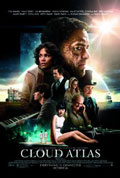
Directed by
Andy Wachowski / Lana Wachowski / Tom Tykwer
172 minutes
Rated MA
Reviewed by
Andrew Lee


Cloud Atlas
Synopsis: People’s lives intertwine and their actions resonate across six time periods, spanning from the mid 19th century to the far distant future.
I have not read David Mitchell’s novel on which this film is based but I understand that it’s a divisive work. Some praise it as genius, others as smart-aleck rubbish. I did try to read Ghost Written, his first novel, which functions under a similar conceit of interlocking stories across time. I thought it was poorly written, sub-standard magic realism and I stopped about halfway through. So you can imagine I didn’t have high hopes going into the cinema. Almost three hours later, I found myself pleasantly surprised. I’m going to have a hard time explaining why I loved Cloud Atlas. But let’s give it a go anyhow.
To begin with, you’re going to think that this is a film is destined for failure. Not only are there six stories running, but the intercutting between them is such that you cannot get a handle on what’s going on anywhere, at any time. You’ll fidget and maybe even check your watch. But slowly events and themes build to the point that things begin to cohere a bit and you at least know who everyone is.
You’ll also start to have favourite stories and characters, many of them played actors such as Tom Hanks, Halle Berry, Jim Broadbent, Hugo Weaving and Hugh Grant playing multiple personae. Hanks and Broadbent are particularly good in this respect. The film, which was co-scripted by the Wachowskis with Tom Twyker, best known for Run Lola Run (1999) cuts quite radically from one storyline to another and you may get annoyed that just as something really interesting is happening in Neo Seoul, you’re suddenly stuck on a slaver’s ship back in the mid 19th century. But the momentum of the stories gradually engage you and the rhythm of the film carries you along.
Finally, the events between times start to flow, both thematically and in consequence. Characters and events from one time appear or are referenced in another as the film articulates its thesis, broadly speaking, that all humankind is interconnected through time, past, present and future, and space. Carl Jung and Joseph Campbell would be proud of the work done here.
Taken individually, the stories would be pretty weak. None of them contain enough meat in and of themselves to carry the narrative, and some would be genuinely awful on their own. But the gestalt creates something beautiful. The first ten minutes of Speed Racer (2008) showed the Wachowskis experimenting with the possibilities of juxtaposed timelines and parallel narratives to yield an invigorating and concise family history. Here, that technique has been expanded to encompass an entire movie and it’s as powerful and effective on the large scale as it was in brief back then, even if at times the film abandons its primary speculative mode and falls back on surprisingly conventional strategies, principally in its handling of the action sequences,
Want something different?





